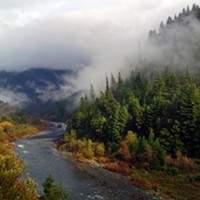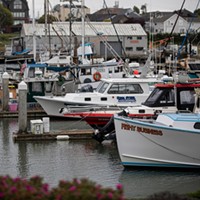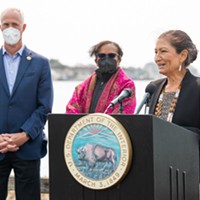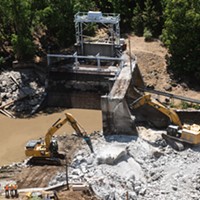Sunday, June 26, 2016
Tribes Threaten Lawsuit Over Klamath Flows
Posted By Thadeus Greenson @ThadeusGreenson on Sun, Jun 26, 2016 at 9:23 AM
The Karuk and Yurok tribes have both put the federal government on notice that they intend to sue, alleging the feds have violated the Endangered Species Act by failing to ensure adequate water flows for Coho salmon on the Klamath River.
Citing a disease infection rate of 90 percent for juvenile salmon last year, spurred by low flows and warm water temperatures, coupled with historically low salmon run projections, the tribes said they felt they had to act.
“We cannot stand by and do nothing while our salmon hover over the brink of extinction,” said Yurok Chair Thomas P. O’Rourke Sr. in a press release. “We will not continue to watch water managers jeopardize the fate of our fish and our river.”
Of course, in addition to fights over water rights in a watershed where the federal government has simply promised more water than exists, water quality problems on the Klamath River are greatly exacerbated by four hydroelectric dams that clog the lower river, block fish passage, raise water temperatures and spur algal blooms. A host of local, state and federal officials stood on the banks of the Klamath near Requa earlier this year to celebrate the signing of a new accord that is planned to result in the removal of those dams in 2020. During the ceremony, Klamath and Yurok leaders pledged to work together with the federal government, upper basin irrigators and ranchers to come to a water sharing agreement that is hoped to avoid this type of litigation in the future. That pledge remains, according to Karuk Chair Russell “Buster” Attebery.
“Our action today in no way diminishes our commitment to work with Klamath irrigators to develop a long term solution that works for fish and farm dependent communities,” Attebery said in a press release. “But until we have a solution in place, we cannot sit idly by while 90 percent of our fish die from disease. This problem could be managed in part by releasing more water at critical times of year.”
The tribes are hoping the federal agencies will work with them to develop a Klamath management plan that includes the release of pulse flows — large, fast releases of water downriver from the dams — that the tribes hope will disrupt the lifecycle of the disease parasite by moving gravel, scouring the river channel and flushing algae and polychaetes downriver.
For more on the historic Klamath dam removal pact and the path forward for the river, see the Journal’s recent cover story here. And for more on the tribes’ threat of litigation, find the press releases below.
From the Karuk Tribe:
KARUK TRIBE TO CHALLENGE KLAMATH RIVER FLOW PLAN
Tribe Files 60 Day Notice Under the Endangered Species Act
Happy Camp, CA – Citing a disease infection rate of 90% of sampled juvenile salmon in 2015, today the Karuk Tribe presented the National Marine Fisheries Service (NMFS) and the Bureau of Reclamation (BOR) with a 60 day notice of intent to sue over violations of the Endangered Species Act.
“We cannot allow mismanagement by federal agencies to destroy what little remains of our fisheries,” said Karuk Chairman Russell ‘Buster’ Attebery.
Earlier this year, the Karuk celebrated when the Obama Administration, California, Oregon, the Yurok Tribe, dam owner PacifiCorp and others agreed on a plan to expedite the removal of the lower four Klamath dams by filing a dam removal plan with the Federal Energy Regulatory Commission. The dam removal agreement calls on signatories to continue efforts to negotiate a long term solution to the water woes that have long plagued Klamath fisheries. Dam removal is planned to take place in 2020.
“Our action today in no way diminishes our commitment to work with Klamath irrigators to develop a long term solution that works for fish and farm dependent communities. But until we have a solution in place, we cannot sit idly by while 90% of our fish die from disease. This problem could be managed in part by releasing more water at critical times of year,” said Attebery.
Flows on the Klamath River are a function of how BOR diverts water to the 225,000 Klamath Irrigation Project from Upper Klamath Lake and the Klamath River to grow alfalfa, potatoes and other crops. Because of the ESA listing of coho salmon, the BOR irrigation plan must be reviewed by NMFS to ensure that diversions don’t jeopardize the survival of the species. NMFS then issues a document known as a Biological Opinion which provides additional rules for how flows must be managed to protect coho salmon.
In 2014 and 2015, the incredibly high rates of infection by the disease causing parasite Ceratonova nova (until recently described as Ceratomyxa shasta) were due in part to low flows and warm water temperatures brought on by the drought. The Biological Opinion (BiOp) is written such that infection rates greater than 49% are not allowable. The BiOp states, “…If the percent of C. Shasta infections for Chinook salmon juveniles in the mainstem Klamath River between Shasta River and Trinity River during May to July exceed these levels (i.e., 54 percent infection via histology or 49 percent infection via QPCR), reinitiation of formal consultation will be necessary.” See page 391, http://www.fws.gov/klamathfallsfwo/news/2013%20BO/2013-Final-Klamath-Project-BO.pdf).
The infection rate of non-listed Chinook salmon are used as a proxy for coho because ESA listed coho salmon are unavailable to sacrifice and analyze.
In a letter to BOR earlier this year, NMFS suggests that it does not intend to re-consult over the BiOp but instead intends to revise its take statement. Or as Karuk Department of Natural Resources Director Leaf Hillman puts it, “They plan to make up new rules for the game during half time.”
According to Karuk Fisheries Biologist Toz Soto, “Throughout the Pacific Northwest, the common denominator for a C. shasta disease problem like this one is large dams paired with large hatcheries. Dams block migration and disrupt the salmon’s natural distribution pattern and cause large concentrations of fish below the dam. This is compounded by the hatchery dumping millions of juveniles into the river during the peak disease infection period. This concentration of juvenile fish, infected fish carcasses, and steady releases of reservoir tail water is the recipe for a C. shasta epidemic.”
According to fisheries biologists, the solution to the problem is removal of the dams and retirement of the hatchery – a process slated to begin in 2020 according to the Klamath Hydroelectric Settlement Agreement. Until then, the Tribe proposes the implementation of a winter and spring pulse flow plan.
“Below the dam, natural flows and sediment transport are disrupted allowing conditions for a small worm like creature called a polychaete to proliferate. This worm is the intermediate host for the disease parasite. With dams in place our only tool to mitigate this problem is to release large pulse flows to disrupt the disease life cycle by moving gravel, scouring the river channel, and flushing out the algae and the polychaetes. This won’t solve the problem, but it will help us manage it until the dams are removed,” said Soto.
The Tribe hopes that agencies will work with them to develop a flow management plan that will allow for such flushing flows, even in drier years, until dam removal is complete. “It’s the dry years that fish need the kind of help that the Endangered Species
From the Yurok Tribe:
Speaking of...
Comments
Showing 1-1 of 1
Readers also liked…
more from the author
-
Seeking Salvation
'Living in amends,' a candidate for resentencing hopes for another chance
- Apr 18, 2024
-
UPDATE: Artillery Shell Deemed Safe in Ferndale
- Apr 12, 2024
-
Our Last Best Chance
- Apr 11, 2024
- More »





































